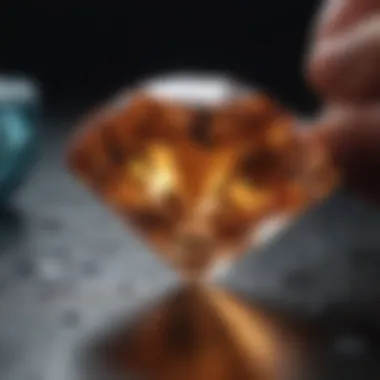Understanding IGA Diamond Certificates for Quality Assurance


Intro
The importance of diamond certificates cannot be overstated. Whether you are a collector, a jeweler, or just someone interested in gemstones, understanding what a diamond certificate entails is crucial. IGA Diamond Certificates play a significant role in the assessment and assurance of a diamond's authenticity and quality. Such certifications are issued by independent grading laboratories that evaluate diamonds based on established criteria.
In this article, we will explore the various dimensions of IGA Diamond Certificates, covering the certification process, key details included in such certifications, and their relevance in the modern diamond market. We will also delve into the implications for buyers and sellers and address critical ethical considerations in diamond sourcing. By the end of this discussion, readers will gain a profound understanding of what IGA Diamond Certificates signify and how they impact the buying and selling of diamonds.
Gemstone Overview
Definition and characteristics
Diamonds are a unique category of gemstones that are renowned for their brilliance and hardness. Formed under extreme pressure and heat deep within the Earth's mantle, diamonds are primarily composed of carbon atoms. The distinct crystalline structure of these stones gives them their exceptional durability and radiant appearance.
Classification of gemstones
Gemstones are classified based on several metrics, including their hardness, clarity, color, and cut. Diamonds fall under the category of precious gemstones, which also includes rubies, sapphires, and emeralds. Each gemstone has a unique set of characteristics and classifications:
- Natural vs. Synthetic: Natural diamonds are formed through geological processes, while synthetic diamonds are created in laboratories.
- Fancy Color vs. White: Fancy color diamonds range in shades, including blue, pink, and yellow, distinguished from colorless or white diamonds.
Understanding these classifications is key to being informed about diamonds and their respective properties.
Properties of Gemstones
Physical properties
Diamonds are distinguished by several exceptional physical qualities. Their hardness is rated at 10 on the Mohs scale, making them the hardest known material. Diamonds also exhibit high refractive index, contributing to their brilliant sparkle. Other noteworthy physical properties include:
- Density: Diamonds have high density, giving them weight.
- Cleavage: A diamond's crystal structure allows it to cleave in specific directions, which is vital during cutting and polishing.
Chemical properties
At a chemical level, diamonds are composed entirely of carbon, with each carbon atom covalently bonded to four others. This bonding arrangement results in extraordinary strength and stability. Some relevant chemical properties include:
- Inertness: Diamonds do not react easily with other chemical substances, which adds to their durability.
- Thermal conductivity: They are excellent thermal conductors, which is why they are used in cutting and drilling tools.
Diamonds’ unique combination of physical and chemical properties underscores their value in the gemstone market and is a key factor that grading laboratories consider when issuing certifications.
Preface to IGA Diamond Certificates
In the realm of fine gemstones, understanding the nuances and importance of certification is paramount. IGA Diamond Certificates serve as a critical resource for anyone interested in purchasing or selling diamonds. Their significance lies not only in verifying the authenticity of the stone but also in providing a comprehensive assessment of its quality attributes. The credibility that a certification brings offers peace of mind to buyers and ensures sellers can present their products with confidence.
Definition and Purpose
An IGA Diamond Certificate is essentially a document issued by the International Gemological Association (IGA) that verifies the quality and authenticity of a diamond. The certificate details various attributes, such as cut, color, clarity, and carat weight, which are essential factors in determining a diamond's value. This documentation plays a vital role in the diamond market by assuring buyers that the diamond they are purchasing has been rigorously evaluated by professionals. The primary purpose of the certificate is to enhance trust in transactions and establish a standard reference for comparing diamonds across different sellers.
Historical Context
The practice of grading diamonds began in the mid-twentieth century, as gemology evolved into a more systematic science. Prior to this, the quality of diamonds was often assessed based on subjective opinions rather than standardized metrics. The establishment of the IGA and the introduction of their diamond certification process marked a significant shift towards transparency in the gemstone industry. Over the years, increased consumer demand for quality assurance drove the adoption of grading certificates. Today, an IGA Diamond Certificate is not just a testament to a diamond’s quality; it symbolizes a commitment to ethical standards and consumer protection in the ever-growing global market.
The Process of Certification
The process of certification for diamonds is crucial for establishing the quality and authenticity of these precious stones. Understanding each stage assists buyers and sellers in making informed decisions. The certification process not only ensures that a diamond meets specific criteria but also adds significant value to a diamond's sale. As the diamond market grows, so does the importance of reliable certification methods.
Diamond Grading Standards


Diamond grading standards are an essential part of the certification process. They provide a systematic approach in evaluating diamonds based on their unique characteristics. The four primary criteria are Cut, Color, Clarity, and Carat Weight. Each of these aspects contributes to the overall quality and desirability of the diamond.
Cut
The "Cut" of a diamond refers to how well the stone has been shaped and faceted. This aspect affects how light reflects off the diamond, influencing its brilliance and sparkle. A well-cut diamond is a beneficial choice for buyers, as it enhances the visual appeal of the stone. The quality of the cut can also impact the diamond's perceived value. A unique feature of a great cut diamond is its ability to mask imperfections, making it appear more flawless than it is, which is an advantageous aspect in this highly competitive market.
Color
The "Color" rating of a diamond assesses the presence of any color within the stone. Diamonds with a D color grade are colorless and extremely rare. This aspect plays a significant role in determining the diamond's value. Buyers usually prefer diamonds with little to no color because they tend to look more desirable. However, some unique color diamonds can also attract attention and demand, such as blue or pink diamonds. The distinct characteristic of color grading is the scale, which ranges from D (colorless) to Z (light yellow or brown). This offers a clear understanding for consumers regarding the stone's quality.
Clarity
"Clarity" measures the presence of internal flaws known as inclusions and surface defects categorized as blemishes. Higher clarity means fewer imperfections, thus increasing the diamond's allure and value. A significant characteristic of clarity grading is that a flawless diamond is extremely rare, making it highly sought after in the market. However, some consumers might prefer diamonds with slight inclusions, as these can often reduce the cost without a noticeable impact on appearance.
Carat Weight
"Carat Weight" quantifies the size of a diamond. Larger carat weights generally correspond with higher values. However, it is essential to remember that carat weight does not solely dictate a diamond's quality. A notable characteristic of carat weight is that the price increases exponentially with larger stones. Therefore, a half-carat diamond may be less expensive than a one-carat diamond, but consumers should be mindful of the other grading factors.
Steps Involved in Certification
Understanding the steps involved in diamond certification helps demystify the process and underscores its importance in the market. Each step plays a critical role in ensuring that every diamond receives a thorough and fair evaluation.
Submission of Diamonds
The first step involves the submission of diamonds to a certification laboratory. Sellers often choose to have their stones evaluated to establish credibility. Also, some buyers may request certificates directly to ensure authenticity before purchase. A key characteristic of this stage is the careful handling procedures to protect the diamonds during the submission process. The unique feature here is that diamonds need to be accompanied by proper paperwork, detailing previous evaluations or ownership history, to facilitate a smoother certification process. It is vital for buyers and sellers to understand this step to avoid any future disputes about the diamond's certifications.
Evaluation by Experts
Once submitted, diamonds undergo a meticulous evaluation by qualified gemologists and experts in the field. This stage is critical, as trained professionals assess the diamond against established grading standards. They will examine features such as Cut, Color, Clarity, and Carat Weight in detail. A notable characteristic of this assessment is its reliance on both subjective and objective analysis. In this stage, using advanced tools and technology adds to the unique value of expert grading. This adds another layer of assurance for buyers, as they can trust the insights provided by knowledgeable figures in the realm of gemstones.
Issuance of Certificate
Upon successful evaluation, the laboratory issues a detailed certificate summarizing its findings. The certificate contains essential details about the characteristics of the diamond and often includes a grading scale explanation and a characteristics chart. A significant aspect of this stage is that it not only serves as an official document of authenticity but also enhances the market value of the diamond. The unique feature of a certificate is the ability to establish a trustworthy foundation for buyers and sellers. However, it is essential to ensure the verification process of the issuing laboratory, as not all certificates carry the same weight in the market.
Key Features of the IGA Diamond Certificate
The IGA Diamond Certificate stands as a benchmark for quality and authenticity within the diamond market. Understanding its key features is vital for both buyers and sellers. This section outlines the essential components that contribute to the credibility and value of the certificate.
Detailed Grading Report
A thorough grading report is a core element of the IGA Diamond Certificate. It brings clarity to the evaluation process. The report details the assessment of the diamond’s essential qualities, which influences its value and desirability.
Grading Scale Explanation
The grading scale used in the IGA certification process provides a standardized method for evaluating diamonds. This scale typically ranges from "Excellent" to "Poor" and assesses various factors such as cut, color, clarity, and carat weight. This systematic approach helps potential buyers to understand and trust the quality of the diamond they wish to acquire.
One significant characteristic of this grading scale is its objectivity. The use of specific criteria allows for consistent ratings across different specimens. This level of reliability is a major reason why the grading scale is an appealing choice for diamond professionals and consumers alike. The transparency it offers supports effective buying and selling decisions. However, it’s important to recognize that personal preferences may still play a role in a buyer's final choice.
Characteristics Chart
The characteristics chart further illustrates the unique features of a diamond, including its specific attributes like brilliance and fire. This chart complements the grading report by providing visual representations of various qualities. Its role is to enhance understanding, making it an essential part of the overall certification.
The chart emphasizes critical traits of the diamond, which can guide consumer decision-making. By visually displaying attributes, the characteristics chart serves as a beneficial tool for consumers to grasp the intricacies of what makes each diamond unique. A potential downside could be the subjective interpretation of visual data; therefore, buyers should combine visual analysis with expert advice.


Laser Inscription
Laser inscription is an innovative feature of the IGA Diamond Certificate. This process involves engraving a unique identifier on the diamond, providing unmatched assurance of authenticity. The inscription acts as a permanent record tied directly to the certification, allowing for easy tracking and verification.
The use of laser inscription benefits buyers by establishing proof of authenticity and supporting an informed purchase. This added layer of security bolsters consumer trust in the diamond market, ensuring that they are investing in a genuine product. However, one must also be aware of the fact that despite its effectiveness, laser inscription can only serve as a verification tool and must be supported by the accompanying grading report for a complete confidence in one's purchase.
The Role of Independent Grading Laboratories
Independent grading laboratories play a pivotal role in the diamond certification process. Their contribution is essential for maintaining the integrity, reliability, and overall trustworthiness of diamond assessments. By relying on trained experts, these laboratories ensure that every aspect of a diamond's quality is scrutinized with precision and objectivity. This objectivity is vital for buyers and sellers in an industry where value can vary dramatically based on perceived quality.
Accreditation and Recognition
Accreditation is a key component that underscores the credibility of independent grading laboratories. An accredited laboratory has met specific standards set by relevant organizations, ensuring the processes and results are consistent and reliable. This recognition adds a layer of trust for consumers. When purchasing a diamond, knowing that the certificate comes from an accredited laboratory can alleviate concerns about quality and authenticity.
Such labs may be recognized by national or international standards, like the ISO (International Organization for Standardization). This recognition often includes maintaining high ethical standards in grading practices. Not only does it establish consistency, but it also protects consumers from fraudulent practices.
Comparison with Other Certification Bodies
The diamond certification landscape includes various organizations, each with differing grading systems and protocols. Independent grading laboratories often differentiate themselves from others through their transparency and rigor in evaluation. For instance, the Gemological Institute of America (GIA) is often contrasted with other bodies like the International Gemological Institute (IGI) or the American Gem Society (AGS).
Here are some considerations regarding these comparisons:
- Grading Standards: Some bodies may adhere to stricter grading standards, leading to variations in final grades. Inconsistency can mislead buyers.
- Reputation: Established organizations usually carry more weight and industry recognition. A GIA certificate may be viewed more favorably than an IGI one due to the former's long-standing reputation.
- Consumer Trust: Buyers often feel more secure when certificates come from recognized entities. This can influence purchasing decisions significantly.
In summary, understanding the significance of independent grading laboratories is crucial for anyone involved in diamond transactions. Their accredited status and the reliability from being recognized provide a framework that helps detect genuine value in an often-unpredictable market. Ensuring that diamonds are evaluated accurately allows for informed choices, fostering trust between buyers and sellers.
Implications for Buyers and Sellers
Understanding the implications of IGA Diamond Certificates is vital for both buyers and sellers in the diamond market. These certificates serve as a verification tool. They provide a comprehensive representation of a diamond's characteristics and value. Knowledge of the certification process enhances consumer confidence. This leads to informed decision-making when purchasing or selling diamonds.
Enhancing Trust in Transactions
Trust is crucial in transactions involving valuable gemstones. An IGA Diamond Certificate assures buyers of the diamond's authenticity, ensuring it has been evaluated by experienced professionals. When a seller presents a certification, it acts as a seal of approval, reducing the risk of selling a misrepresented stone. Clear communication of the certification details builds a rapport between parties.
For buyers, this trust translates into a commitment to quality. They can shop with assurance, knowing that professionals have assessed the diamond using standardized criteria. Buyers are less likely to question the value and integrity of their investment, which is particularly important in high-stakes purchases. A certified diamond often commands a premium price, reflecting its reliable grading. Conversely, sellers benefit from an enhanced reputation. They can attract more discerning customers willing to pay more for certified stones.
"An IGA Diamond Certificate is not just a document; it is a bridge between buyers and sellers, fostering trust and transparency in the gemstone market."
Understanding the Value Proposition
The value proposition of IGA Diamond Certificates encompasses several key points that affect the dynamics of buying and selling diamonds. Firstly, certified diamonds are almost universally regarded as more valuable than non-certified ones. Buyers are typically more inclined towards diamonds with certification since these documents outline grades for cut, color, clarity, and carat weight. This clarity aids buyers in making educated choices based on their preferences and budget.
Secondly, the presence of a certificate can simplify the resale process. Sellers can present certified diamonds with documented evaluations, giving future buyers confidence in their choice. This aspect is particularly important for collectors and investors who intend to resell their gems later. The certificate ascertains the diamond's pedigree, thus enhancing its appeal on the market.
Finally, the overall demand for ethically sourced diamonds is rising. Buyers are more aware of the importance of responsible sourcing. IGA’s commitment to ethical practices firmly aligns with this consumer trend. Buyers who know their diamond has been certified under ethical standards are likely to perceive it as a more desirable purchase.
In summary, the implications of IGA Diamond Certificates for buyers and sellers foster a marketplace of trust. These certificates enhance buyer confidence while simultaneously promoting seller credibility. Understanding these factors emphasizes the indispensable role of certification in the modern diamond trade.
Ethical Sourcing and IGA Certification
Ethical sourcing has grown in importance in recent years. As consumers become more aware, there is a greater demand for transparency in the diamond industry. IGA Diamond Certification plays a pivotal role in ensuring that diamonds are sourced responsibly. This certification not only addresses quality but also emphasizes ethical practices. Buyers want to know where their diamonds come from and under what conditions they were mined.
Responsible Mining Practices


The essence of responsible mining lies in its approach to human rights and environmental protection. Companies involved in diamond mining are increasingly adopting sustainable methods. These practices focus on minimizing environmental damage, protecting local communities, and ensuring fair labor conditions.
- Environmental Responsibility: Efforts are made to reduce habitat destruction and pollution during extraction. This includes careful management of mining sites and rehabilitation of areas post-extraction.
- Respect for Local Communities: Mining operations often affect surrounding communities. Responsible practices ensure that the rights of indigenous people are upheld. This can include engagement with community leaders and compensating them fairly.
- Safe Labor Practices: Ethical sourcing also means ensuring workers' rights are respected. This includes avoiding child labor, providing fair wages, and ensuring safe working conditions.
By adhering to responsible mining practices, companies can contribute to a more ethical diamond industry.
Conflict-Free Diamonds
The term "conflict-free diamonds" refers to diamonds that are sourced from regions not involved in armed conflict or human rights abuses. The IGA certification process scrutinizes the origin of diamonds to verify they do not fund violence or exploitation. This is a crucial aspect in the certification of diamonds.
- Traceability: IGA ensures that every diamond is traceable back to its point of origin. This transparency builds trust with consumers who seek ethically sourced products.
- Industry Standards: Compliance with established industry standards is essential. The Kimberley Process Certification Scheme serves as a foundational element in this regard. It aims to prevent the trade of conflict diamonds by regulating international trade.
- Consumer Awareness: Today's consumers prioritize ethical considerations when purchasing diamonds. The demand for conflict-free diamonds drives companies to adopt more transparent sourcing practices.
Overall, the certification of conflict-free diamonds enhances buyer confidence and ensures that their purchases do not contribute to violence or human suffering.
"Ethically sourced diamonds symbolize trust and integrity. They represent a commitment to responsible practices in an often opaque industry."
Current Trends in Gemstone Certification
The world of gemstone certification is evolving. As awareness grows among consumers and sellers, new trends emerge that shape the industry. These trends not only improve the credibility of the certification process but also enhance the overall trust in buying and selling gemstones. Understanding these trends is crucial for those engaged in the gemstone market.
Technological Advancements
Technology plays a significant role in the current trends of gemstone certification. The use of advanced tools and software has improved the accuracy and reliability of grading gemstones. For instance, Spectroscopy and X-ray fluorescence are now commonly used. These technologies help in identifying the composition of stones, ensuring they match the claimed specifications.
With the introduction of blockchain technology, traceability of gemstones has seen a positive shift. Blockchain provides a transparent ledger of the gemstone’s journey from the mine to the market. This system greatly aids in preventing fraud and ensures that the buyer knows the stone's history.
Some labs are also adopting 3D imaging techniques. This allows for detailed visual inspections that were not possible before. Such advancements mean that customers can receive comprehensive information, boosting confidence in their purchase. Additionally, digital certificates are becoming popular, providing quick and easy access to certification details online.
Consumer Awareness and Education
As technology advances, consumer awareness is also on the rise. Buyers today are more informed than ever about the importance of certification in the gemstone market. Social media and online forums have facilitated discussions regarding the authenticity and quality of gemstones. Platforms like Reddit and Facebook have groups dedicated to gemstone enthusiasts, where they share insights, experiences, and advice.
Moreover, educational resources are now more accessible. Organizations and websites offer courses and articles providing in-depth knowledge about gemstone grading. This increased awareness leads to buyers asking more questions and seeking verified information, making them less susceptible to scams.
"An informed consumer is the best defense against fraud in the gemstone market."
As a result, sellers must now be more transparent about their certification and sourcing processes. This trend not only benefits buyers but also elevates the entire market, causing it to adhere to higher standards of quality and ethics.
Culmination and Future Directions
In the landscape of diamond certification, IGA Diamond Certificates play a pivotal role in educating consumers and assuring them of the quality and authenticity of their purchases. Understanding the importance of these certificates allows both buyers and sellers to navigate the diamond market with confidence. This article covers various critical aspects, emphasizing the certification processes, key features, and implications for ethical sourcing.
Summary of Key Points
The significance of IGA Diamond Certificates centers around several key points:
- Assurance of Quality: The detailed grading reports ensure that consumers understand the quality of the diamonds they are purchasing.
- Consumer Confidence: Knowledge of the grading standards and independent assessment helps build trust between buyers and sellers.
- Ethical Considerations: Awareness of responsible sourcing elevates consumer choices, contributing to the demand for conflict-free diamonds.
- Technological Integration: Advances in technology are increasingly shaping the methods used in grading and certification, enhancing transparency.
- Market Trends: Monitoring current trends enables stakeholders to adapt to evolving consumer needs and preferences in gemstone certification.
Understanding these elements is essential for making informed decisions, ultimately reflecting in positive outcomes for all parties involved.
The Future of Diamond Certification
Looking ahead, the future of diamond certification appears promising yet complex. As technology continues to develop, blockchain and artificial intelligence may become integral in enhancing the traceability and authenticity of diamonds. This evolution could pave the way for a more secure certification environment, reducing the risk of fraud in the industry.
Moreover, there is growing emphasis on sustainable practices. Consumers are increasingly seeking assurance that their purchases support ethical mining practices. The demand for certified ethical diamonds is rising, pushing grading laboratories to innovate in their standards and processes.
Also, education and awareness programs will likely continue to play a significant role in shaping consumer behavior. As more gemstone enthusiasts become knowledgeable about certification processes, the demand for quality assurance will further drive industry standards.
In summary, the trajectory of IGA Diamond Certificates will significantly depend on advancements in technology, ethical considerations, and consumer awareness. These factors combined will influence the future landscape of the diamond market, highlighting the importance of ongoing education and certification integrity.



